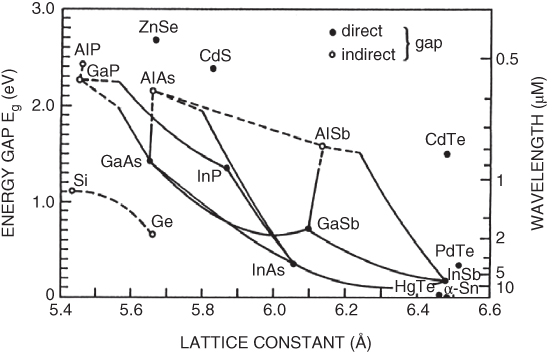14Molecular‐Beam Epitaxy of Antimonides for Optoelectronic Devices
Eric Tournie
IES, Université de Montpellier, CNRS, F‐34000 Montpellier, France
14.1 Introduction
Among III–V semiconductors the so‐called “antimonides” refer to the Sb‐rich III–V compounds. They include GaSb, InSb, and AlSb which can all be alloyed with InAs to form ternary, quaternary, or even quinary alloys closely lattice‐matched to GaSb or InAs substrates. Figure 14.1 shows that the III–Sb multinary materials span a large bandgap range from 0.1 eV up to 1.8 eV while still being nearly lattice‐matched to GaSb. In addition, the positions of the band edges, displayed in Figure 14.2 for the III–As and III–Sb binary compounds, reveal that III–Sbs offer the opportunity to realize a large variety of band alignments, from type‐I, where electron and holes are confined in the same material (e.g. AlGaSb/GaSb, GaSb/GaInSb), to type‐III, also known as staggered type‐II or broken‐gap type II, where the conduction band of one material is located below the valence band of the next one (e.g. GaSb/InAs) through type‐II systems (e.g. AlSb/InAs). Finally, it is noticeable that III–Sbs exhibit high carrier mobilities. InSb and GaSb have, respectively, the highest electron and hole mobilities among all compound semiconductors, while InAs has the second highest electron mobility [1].

Figure 14.1 Energy gap vs. lattice parameter of various ...
Get Molecular Beam Epitaxy now with the O’Reilly learning platform.
O’Reilly members experience books, live events, courses curated by job role, and more from O’Reilly and nearly 200 top publishers.

